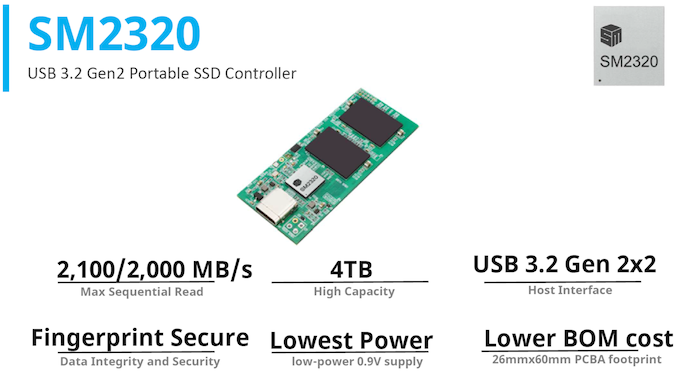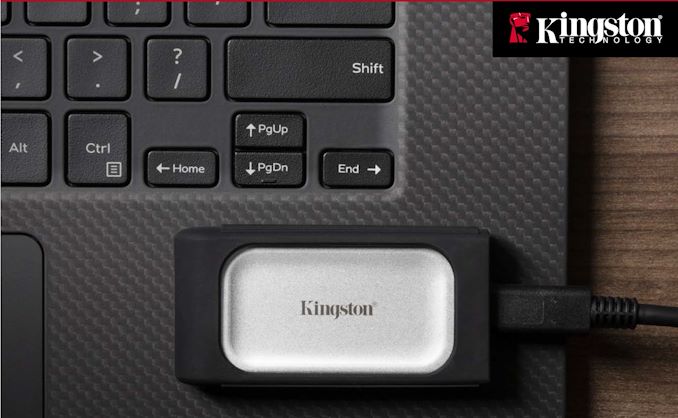USB 3.2 Gen 2x2 Portable SSDs Go Native: The Silicon Motion SM2320 UFD Controller Preview
by Ganesh T S on September 16, 2021 8:00 AM EST- Posted in
- Storage
- SSDs
- Kingston
- DAS
- Silicon Motion
- External SSDs
- USB 3.2 Gen 2x2
Miscellaneous Aspects and Concluding Remarks
The performance of the storage bridges / drives in various real-world access traces as well as synthetic workloads was brought out in the preceding sections. We also looked at the performance consistency for these cases. Power users may also be interested in performance consistency under worst-case conditions, as well as drive power consumption. The latter is also important when used with battery powered devices such as notebooks and smartphones. Pricing is also an important aspect. We analyze each of these in detail below.
Worst-Case Performance Consistency
Flash-based storage devices tend to slow down in unpredictable ways when subject to a large number of small-sized random writes. Many benchmarks use that scheme to pre-condition devices prior to the actual testing in order to get a worst-case representative number. Fortunately, such workloads are uncommon for direct-attached storage devices, where workloads are largely sequential in nature. Use of SLC caching as well as firmware caps to prevent overheating may cause drop in write speeds when a flash-based DAS device is subject to sustained sequential writes.
Our Sequential Writes Performance Consistency Test configures the device as a raw physical disk (after deleting configured volumes). A fio workload is set up to write sequential data to the raw drive with a block size of 128K and iodepth of 32 to cover 90% of the drive capacity. The internal temperature is recorded at either end of the workload, while the instantaneous write data rate and cumulative total write data amount are recorded at 1-second intervals.
| Sequential Writes to 90% Capacity - Performance Consistency | |
| TOP: | BOTTOM: |
 |
|
The SM2320 reference design is able to sustain 1600MBps+ writes for close to 65 seconds before dropping down to the 100MBps range. This points to a SLC cache of around 108GB - slightly more than 10% of the drive's capacity. Even after running out of the SLC cache, the drop in transfer rate allows the controller to regain some of the cache by moving data to the TLC segment while the direct-to-TLC writes are in progress. This enables the sudden regular spikes of the transfer rate to the 1GBps mark. The lack of any thermal solution (note that we are evaluating a bare PCB here) means that we can't make any comments on the recorded temperature.
Power Consumption
Bus-powered devices can configure themselves to operate within the power delivery constraints of the host port. While Thunderbolt ports are guaranteed to supply up to 15W for client devices, USB 2.0 ports are guaranteed to deliver only 2.5W (500mA @ 5V). In this context, it is interesting to have a fine-grained look at the power consumption profile of the various external drives. Using the Plugable USBC-TKEY, the bus power consumption of the drives was tracked while processing the CrystalDiskMark workloads (separated by 5s intervals). The graphs below plot the instantaneous bus power consumption against time, while singling out the maximum and minimum power consumption numbers.
| CrystalDiskMark Workloads - Power Consumption | |
| TOP: | BOTTOM: |
 |
|
The above graph backs up the power-efficiency claims of Silicon Motion with respect to the SM2320. A peak of 3.84W is much lower than the 5.88W peak obtained with the most power-efficient SK hynix P31 SSD behind the ASMedia ASM2364 bridge chip. The idle power (0.7W) matches the other native UFD solution in the Phison U17 (though that chip is a USB 3.2 Gen 2 solution, unlike the SM2320's Gen 2x2). However, this power number is higher than the best bridge solution's 0.49W. Otherwise, for long idle periods, the reference design will go to a completely idle state (sipping as low as 9mW) after around 20 minutes.
Final Words
Silicon Motion's SM2320 reference design allowed us to get an idea of the capabilities of high-performance native USB flash drive (UFD) controllers in a USB 3.2 Gen 2x2 configuration. The company also has a USB 3.2 Gen 2 solution in the SM2321, which will be looked at in a retail product shortly.
Performance-wise, the product ends up behaving similarly to a DRAM-less PCIe 3.0 x4 NVMe SSD behind a USB 3.2 Gen 2x2 bridge. The lack of DRAM for flash management may affect the performance for certain workloads, but that is more than made up for by the liberal amount of SLC cache – more than 10% of the drive's capacity. Write-intensive workloads with a larger active set can get negatively affected, but most consumers on the lookout for a UFD controller-based portable SSD are unlikely to put their drive through such access traces. Retail products based on the SM2320 are likely to be much smaller than dual-chip (bridge + controller) solutions.
The success of any product depends on the pricing. While we do not have any idea of what Silicon Motion charges its customers for the SM2320, we do have a product already in retail using the solution - the Kingston XS2000.
At $160, it undercuts the WD_BLACK P50 and Seagate FireCuda Gaming SSD by $50. Even a DIY solution with the SK hynix P31 and the SilverStone MS12 ends up at $185. While some of these costlier solutions offer better performance for some workloads, the XS2000 wins on the power efficiency front. Silicon Motion and Kingston seem to have the right pricing strategy to ensure that USB 3.2 Gen 2x2 continues to gain traction in the market.













18 Comments
View All Comments
nandnandnand - Friday, September 17, 2021 - link
Ugh, I don't ever want to read "Gen NxN" again.AMD Rembrandt should support dual USB 4. Which I guess means up to two 40 Gbps ports. Anything before that, no.
Spunjji - Monday, September 20, 2021 - link
AFAIK, only 10Gbps is guaranteed without the bridge.nvmnghia - Saturday, September 18, 2021 - link
So is there a controller that offers:- Thunderbolt if supported
- Flash to USB for all cases else (max USB speed of the host)
Bananas64 - Friday, September 24, 2021 - link
Isn’t a write speed of only 100 MB/s after SLC cache pretty much evidence of QLC flash?I have never seen a TLC SSD with such a low write speed after the SLC cache, but pretty much every QLC SSD has it.
webdigital - Wednesday, October 6, 2021 - link
Experience from Hong Kong has demonstrated the advantages of the framework. Notwithstanding, the framework can be <a href="https://gyanmatrix.com/build-operate-transfer-mode... ">Build Operate Transfer Model</a> extremely hazardous conceivably. The three transportation projects in Thailand, including the Second Expressway System, Don Muang Tollway and the Bangkok Elevated Transport System, have given financial backers an excruciating encounter. Breaking down these effective and bombing models, this investigation has closed the elements of a fruitful BOT project.tripvisit - Saturday, October 9, 2021 - link
Cozily nuzzled amidst the mesmerizing environment of breathtaking hilly terrain beside the dense wooded area of the well-known Corbett National Park, the lovely De Floresta resort gives the lavish and tranquil vacation far from the hustle and bustle of the town lifestyles. The calm and serene environment of the resort complimenting the woodland locality is the proper gateway to a rejuvenating and enjoyable holiday. https://tasteoftrip.com/best-resorts-in-jim-corbet... Located within the Kyari Kham village around nine km from the Ramnagar city, the resort is without problems on hand from the nearest Bus stand and Railway station of Ramnagar.boardmotherz - Wednesday, December 15, 2021 - link
Assuming you can't presently utilize programming to check your motherboard type, there's consistently the choice to check it actually. www.bestmotherboardreview.com You ought to pick this choice assuming your PC won't turn on or the motherboard isn't as of now introduced. It's not the favored strategy assuming you have a PC since parts might be put before the motherboard itself.boardmotherz - Wednesday, December 15, 2021 - link
Assuming you can't presently utilize programming to check your motherboard type, there's consistently the choice to check it actually. <a href="www.bestmotherboardreview.com">top mother board review</a> You ought to pick this choice assuming your PC won't turn on or the motherboard isn't as of now introduced. It's not the favored strategy assuming you have a PC since parts might be put before the motherboard itself.